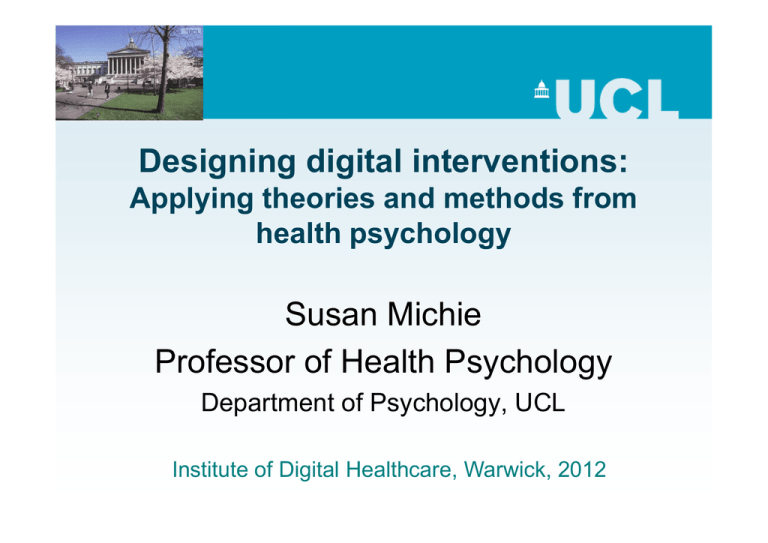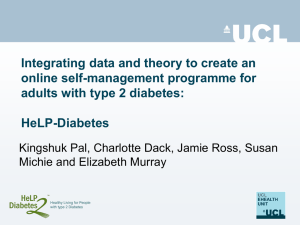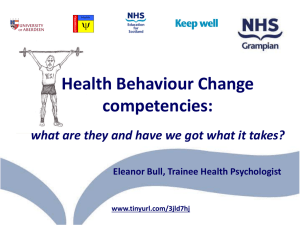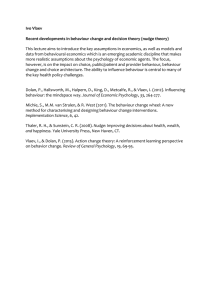Designing digital interventions: Susan Michie Professor of Health Psychology
advertisement

Designing digital interventions: Applying theories and methods from health psychology Susan Michie Professor of Health Psychology Department of Psychology, UCL Institute of Digital Healthcare, Warwick, 2012 Acknowledgements • Collaborators – – – – Prof Robert West, Dr Jamie Brown, UCL Prof Lucy Yardley, University of Southampton Dr Tom Webb, University of Sheffield Dr Cari Free, LSHTM • Funders This talk • Principles of designing behaviour change interventions – Evidence e.g. NICE – Specifying intervention components – Theory – mechanisms of action • Advantages and challenges of digital interventions – StopAdvisor - internet – Txt2Stop – text message – Ubhave – mobile phones and social media as sensors Why don’t people behave in ways that promote health? The COM-B system: Behaviour occurs as an interaction between three necessary conditions Psychological or physical ability to enact the behaviour Reflective and automatic mechanisms that activate or inhibit behaviour Physical and social environment that enables the behaviour Michie et al (2011) Implementation Science Effective principles of individual behaviour change • Maximise capability to regulate own behaviour – Develop relevant skills (e.g. goal setting, monitoring, feedback) – Develop specific plans to change • Strengthen motivation to engage in the desired behaviour – Reward change – Develop appropriate beliefs • E.g. benefits of changing, others’ approval, personal relevance, confidence to change – Develop positive feelings about changing • Reduce motivation to continue with the undesired behaviour • Maximise opportunities to support self-regulation – Elicit social support – Avoid social and other cues for current behaviour – Change routines and environment Abraham, Kelly, West & Michie, 2008, Psychology, Health and Medicine A system for designing effective interventions 1. 2. 3. 4. 5. Start with the target behaviour Consider full range of possible interventions Identify specific behaviour change techniques Understand mechanisms of action Ensure they are delivered/engaged with as planned 1. Understand the nature of the target behaviour • Unless we understand the nature of the behaviours that need to change, unlikely our interventions will be maximally effective • Start with a model of behaviour – COM-B • What needs to change for the desired behaviour/s to occur? A system for designing effective interventions 1. 2. 3. 4. 5. Start with the target behaviour Consider full range of possible interventions Identify specific behaviour change techniques Understand mechanisms of action Ensure they are delivered/engaged with as planned Need a framework for designing interventions with following criteria: 1. Comprehensive coverage 2. Coherence 3. Clear link to a model of behaviour Useable by, and useful to, policy makers, service planners and intervention designers Do we have such a framework? • Systematic literature review identified 19 existing frameworks – none met all these criteria • Development of new framework – Model of behaviour at the hub of a wheel – Synthesis of existing frameworks • 9 intervention functions – each include one or more behaviour change techniques • 7 policy categories – that could enable or support these interventions to occur Michie et al (2011) The Behaviour Change Wheel: a new method for characterising and designing behaviour change interventions, Implementation Science. Behaviour at the hub …. COM-B Result • The Behaviour Change Wheel – A system for choosing interventions and policies Interventions Interventions: activities designed to change behaviours Policies Intervention functions Policies: decisions made by authorities concerning interventions Michie et al (2011) The Behaviour Change Wheel: a new method for characterising and designing behaviour change interventions Implementation Science Linking COM-B to intervention functions Ed CPh CPs OPh OSo MA MR Pers Inc Coer Tra Res Env Mod Ena Linking COM-B to intervention functions Ed CPh CPs OPh OSo MA MR Pers Inc Coer Tra Res Env Mod Ena Intervention functions are delivered by one or more behaviour change techniques (BCTs) • “Active ingredients” within the intervention designed to change behaviour • They are – observable, – replicable and – irreducible components of an intervention • Can be used alone or in combination with other BCTs Behaviour change techniques: reliable taxonomy Involves detailed planning of what the person will do to change physical activity and healthy eating behaviours including, at least, a very specific definition of the behaviour e.g., frequency (such as how many times a 15. General encouragement General information day/week), intensity (e.g., speed) or duration (e.g., for how long for). In addition, at least one of therewards following contexts 16. Contingent Information on consequences i.e., where, when, how or with whom must be specified. 17. Teachoftosub-goals use cues Information about approvalThis could include identification or preparatory contexts which the behaviour 18. Follow upinprompts Prompt intention formationbehaviours and/or specific will be performed. 1. 2. 3. 4. 5. Specific goal setting 6. Graded tasks 7. Barrier identification 8. Behavioral contract 9. Review goals 10. Provide instruction 11. Model/ demonstrate 12. Prompt practice 13. Prompt monitoring 14. Provide feedback 19. Social comparison 20. Social support/ change 21. Role model 22. Prompt self talk 23. Relapse prevention 24. Stress management 25. Motivational interviewing 26. Time management The person is asked to keep a record of specified behaviour/s. This could e.g. take the form of a diary or completing a questionnaire about their behaviour. Abraham & Michie (2008). A taxonomy of behavior change techniques used in interventions. Health Psychology. Further development • Smoking cessation: 53 BCTs Michie et al, Annals Behavioral Medicine, 2010 • Physical activity & healthy eating: 40 BCTs Michie et al, Psychology & Health, 2011 • Reducing excessive alcohol use: 42 BCTs Michie et al, Addiction, 2012 • General behaviour change: 137 BCTs Michie et al, Applied Psychology: An International Review, 2008 • Current MRC funded study: 89 BCTs www.ucl.ac.uk/health-psychology/BCTtaxonomy Applying BCTs and theory to understanding internet interventions Background and question • Reviews of Internet-based interventions suggest statistically small and highly variable effects – Shahab & McEwen 2009, Addiction – Portnoy et al. 2008, Preventive Medicine • Why are some internet-based interventions effective and others not? • What features characterise effective interventions and how can we learn from them? • Previous reviews have not systematically coded the characteristics of each Internet-based intervention and computed the effect size associated with each – Behaviour change techniques – Modes of delivery – Theoretical basis • Thus, we have little insight into why some interventions are effective while others are less effective The review • Search – Web of Knowledge • Web-based, Internet, digital, online, technolog*, computer, treatment, RCT, trial, intervention, behavio* change. – Expert consultation • Inclusion criteria – – – The primary components of the intervention delivered via the Internet Random assignment of participants to an Internetbased intervention vs a control or no intervention A measure of behaviour related to health after the intervention Measures • 40 item taxonomy of BCTs – Michie et al, Psychology and Health, 2010 • Theory Coding Scheme – Michie & Prestwich, Health Psychology, 2010 • Mode of delivery – Automated functions • Use of an enriched information environment • Automated tailored feedback • Automated follow-up messages – Communicative functions included • Access to an advisor to request advice • Scheduled contact with advisor • Peer-to-peer access – Use of supplementary modes included: • Email, telephone, text messages (SMS), CD-ROM, or videoconferencing Flow of information through the different phases of the review 6975 records identified through database searching 7 additional records identified in response to distribution list email 6982 records screened 140 studies did not include a measure of behaviour related to health 97 studies did not deliver the primary components of the intervention via the Internet 549 full-text articles screened for eligibility 88 studies did not report intervention effects 84 studies did not include a control group 20 studies only used computers to tailor information that was presented in a non-computerized format 85 interventions included in the metaanalysis 17 studies reported additional effects of an intervention already included in the review 17 studies excluded for other reasons Effect sizes for behaviour change as a function of Internet-based interventions behaviour k Q 95% CI d+ Physical activity 20 128.76 0.09 to 0.38 0.24 Dietary behaviour 10 30.82 0.02 to 0.37 0.20 Alcohol consumption 9 47.45 0.00 to 0.27 0.14 Smoking abstinence 12 45.46 -0.04 to 0.18 0.07 All studies 85 896.67 0.09 to 0.23 0.16 Use of Theory k Q 95% CI d+ Theory used to select recipients 3 2.84 0.15 to 0.52 0.33 Group of intervention techniques linked to group of constructs Theory/predictors used to select intervention techniques Targeted construct mentioned as predictor of behaviour Theory used to tailor intervention techniques to recipients Theory or model of behaviour mentioned 6 9.85 0.03 to 0.43 0.23 37 191.40 0.13 to 0.29 0.21 18 60.07 0.11 to 0.31 0.21 11 67.75 0.07 to 0.34 0.21 30 161.33 0.11 to 0.28 0.19 At least one intervention technique is linked to theory Intervention based on single theory 19 93.65 0.09 to 0.29 0.19 12 57.13 0.05 to 0.32 0.18 All constructs are linked to intervention techniques 10 47.70 -0.02 to 0.37 0.18 At least one construct is linked to an intervention technique All intervention techniques are linked to theory 18 70.63 0.17 2 0.07 to 0.27 Use of Theory Effect size = -.07 + .03 (use of theory) 0.30 Effect size (d) 0.20 0.10 0.00 0 1 2 3 4 -0.10 -0.20 Use of theory 5 6 7 Theoretical Basis Theory of Planned Behaviour Transtheoretical Model Social Cognitive Theory Elaboration Likelihood Model Extended Parallel Process Self-Regulation Theory Precaution Adoption Process Diffusion of Innovations Health Belief Model Social Norms Theory k Q 95% CI d+ 9 12 12 2 1 1 1 1 1 1 108.44 68.99 18.62 0.15 to 0.56 0.08 to 0.33 0.04 to 0.25 0.36 0.20 0.15 Behaviour change techniques with above average effect sizes Stress management Communication skills training Modelling Relapse prevention Facilitate social comparison Goal setting (behaviour) Action planning Provide performance feedback Barrier identification Teach to use prompts/cues k Q 95% CI d+ 5 3 5 14 4 25 18 19 26 3 6.73 4.38 24.80 38.31 3.25 126.24 101.67 77.38 112.52 5.45 0.27 to 0.72 0.25 to 0.73 -0.01to 0.70 0.17 to 0.47 0.04 to 0.55 0.16 to 0.38 0.13 to 0.37 0.09 to 0.34 0.10 to 0.30 -0.17 to 0.57 0.50 0.49 0.35 0.32 0.29 0.27 0.25 0.22 0.20 0.20 BCTs with smaller effects Provide normative information Plan social support Provide rewards for behaviour Self-monitoring (behaviour) Info. on conseq. (general) Info. on conseq. (individual) Use of follow up prompts Self-monitoring (outcome) Reinforcing effort Emotional control training Info. about others’ approval k Q 95% CI d+ 16 15 7 28 29 12 5 13 3 11 5 94.32 41.32 7.17 80.81 114.14 47.57 39.35 45.73 2.89 35.39 10.48 0.07 to 0.28 0.10 to 0.27 0.09 to 0.28 0.07 to 0.24 0.06 to 0.21 0.04 to 0.24 -0.10 to 0.35 -0.03 to 0.26 0.02 to 0.19 -0.03 to 0.22 -0.11 to 0.23 0.18 0.18 0.18 0.16 0.14 0.14 0.13 0.12 0.11 0.09 0.06 Behaviour change techniques Effect size = -.13 + .05 (no. beh change techniques) Mode of delivery Automated functions Automated tailored feedback Enriched info. environment Automated follow-up Additional modes Text message (SMS) Telephone Email Communicative functions Access to advisor Scheduled advisor contact Peer-to-peer access k Q 95% CI d+ 18 30 14 83.75 117.24 49.81 0.07 to 0.28 0.07 to 0.23 -0.01 to 0.19 0.18 0.15 0.09 4 7 19 39.22 19.02 143.98 0.14 to 1.49 0.09 to 0.61 0.07 to 0.29 0.81 0.35 0.18 23 13 20 121.15 35.70 88.21 0.16 to 0.42 0.09 to 0.36 0.09 to 0.21 0.29 0.22 0.20 Summary • More extensive use of theory was associated with increases in effect size • Interventions that incorporated more BCTs tended to have larger effects • Efficacy was enhanced by the use of additional methods of communicating with participants – Text messages • See review by Heron & Smyth, 2010, BJHP Example of a theory-based internet intervention: The Internet-based Smoking Cessation Intervention trial Development and piloting StopAdvisor Team • Robert West, Susan Michie, Jamie Brown, Andy McEwen, Ben Gardner Sood, Lion Shahab & John Stapleton • Adam Geraghty, Sascha Miller, Judy Joseph & Lucy Yardley Funded by National Prevention Research Initiative Why Develop a new Internet Intervention for smoking cessation? • Reviews noted efficacy but also heterogeneity in efficacy, quality and design – Civljak et al, 2010; Myung et al, 2009; Shahab & McEwen, 2009; Etter, 2006 • Not widely used particularly by disadvantaged smokers, and many not applicable to UK • Little usability testing by potential users • Under-reporting of content – e.g., Strecher, 2008 Intervention design platform www.lifeguideonline.org/ • Open source web-based platform for developing and evaluating behaviour change interventions • No specialist knowledge of programming languages needed • Virtual Research Environment (VRE), allowing fluid feedback, comments and amendments – Allows easy sharing of code and content & altering specific features to examine the resulting effects Developing a new Internet Intervention 1. 19 principles from PRIME theory – West, 2006 2. 33 BCTs based on evidence from smoking and behavioural science – – – Shabab & McEwen, 2009; Michie, Churchill & West, 2010 other reviews of behaviour change interventions observational data from the NHS Stop Smoking Services 3. 26 principles of website design identified from study team 4. Usability testing with target audience – Disadvantaged smokers Michie et al. (in press) Development of StopAdvisor, a theory-based interactive, internet-based smoking cessation intervention. Translational Behavioral Medicine. Intervention Content • Included 33 evidence- or theory-based BCTs • 4 categories of BCTs – provide rewards contingent on stopping & strengthen ex-smoker identity – advise on changing routines and environmental restructuring – advise how to use medication optimally – tailoring of materials & rapport building. • Linked in an overarching theme of an advisor to help smokers stop using structured quit plan and a ready source of information Intervention Content • Implemented according to principles of website design Principle / BCT Intervention content Website design Construct personal rule to Introduction of motto: ‘Not generate strong resolve a puff, no matter what’ & (Strengthen ex-smoker image to support identity) Image attractive; simple motto; interactive – use site, emails & texts to deliver Intervention Format • Hybrid architecture to combine tunnelled exposure to key messages and choice of content from menus • Tunnelled dialogue is presented across maximum of 18 tailored and interactive log-in sessions Pilot study • Aims: – evaluate whether cessation, website usage and satisfaction were sufficiently high to warrant a RCT – assess whether outcomes were affected by SES • Methods: – 204 adult daily smokers willing to make a serious quit attempt who received support from ‘StopAdvisor’ – Primary outcome was biochemically verified 1 month of continuous abstinence – Usage and satisfaction assessed Results • 19.6% of participants were abstinent according to the primary outcome (95% C.I. = 14.1% to 25.1%) – double the equivalent figure in unaided quitting and satisfied the a priori criterion set by a steering committee • Participants viewed a mean of 133.5 pages (median = 71.5) during 6.4 log-ins (median = 3) • A majority of respondents rated the website positively on each of the four satisfaction ratings (range 66.7% - 75.3%) • No evidence of an effect of socio-economic status on abstinence, usage or satisfaction • RCT is recruiting well, results due end of year This talk • Principles of designing behaviour change interventions – Theory and evidence e.g. NICE – Specifying intervention components – Theory – mechanisms of action • Advantages and challenges of digital interventions – StopAdvisor - internet – Txt2Stop – text message – Ubhave – mobile phones and social media as sensors Mobile phones for behaviour change Mobile phone ownership is high (at least 81% across all socioeconomic groups) 24 hour support Confidential Convenient Interactive Personalised • Mobile phone based smoking cessation support • RCT of effects on biochemically verified continuous abstinence at six months Free, C., et al., Smoking cessation support delivered via mobile phone text messaging (txt2stop): a single-blind, randomised trial. Lancet, 2011. 378 (9785): p. 49-55 Intervention participants were asked to set a ‘quit date’ intensive support: 5 personalised text messages were sent to mobile phones on a daily basis for 5 weeks text message frequency then reduced to 3 per week for six months Control received fortnightly text messages unrelated to quitting The intervention regular personalised text messages providing smoking cessation information, motivation, feedback, distraction, social support interactive: ‘CRAVE’, ‘LAPSE’, ‘Quit buddy’ (optional) matched on interests and concerns over quitting (e.g. weight gain) Results Primary outcome: biochemically verified quitting at six months Intervention group % (n) Control group % (n) 10.7% Missing data treated as smokers Missing data excluded Primary analysis (multiple imputation for missing values) Relative risk (95%CI) P-value 4.9% 2.20 (1.80, 2.68) <0.0001 9.2% 268 4.3% 124 2.14 (1.74, 2.63) <0.0001 9.8% 268 4.4% 124 2.20 (1.79, 2.71) <0.0001 Behaviour change technique analysis • 899 texts delivered 34 BCTs – 218 aimed to maintain motivation to remain abstinent – 870 to enhance self-regulatory capacity or skills – 39 to promote use of adjuvant behaviours such as using stopsmoking medication – 552 to maintain engagement with the intervention – 24 were general communication techniques Michie, Free & West (in press) Characterising the ‘Txt2Stop’ smoking cessation text messaging intervention in terms of behaviour change techniques. Journal of Smoking Cessation. Ubhave: Ubiquitous and social computing for positive behaviour change Social Scientists: Lucy Yardley Jason Rentrow Peter Smith Susan Michie Computer scientists: Cecilia Mascolo Mark Weal Mirco Mucolesi Dave de Roure Aim and background • To investigate the power and challenges of using mobile phones and social networking for Digital Behaviour Change Interventions (DBCIs), and to contribute to a scientific foundation for digitally supported behaviour change • DBCIs are interactive, automated packages of advice and ongoing support for behaviour change, providing: – personalised advice based on the user’s needs, situation and preferences – support for goal-setting, planning and progress monitoring – automated reminders and progress-relevant feedback and encouragement – access to social support by email, online forums etc. Key research questions • How can we accurately, efficiently and unobtrusively measure what mobile phone users are doing and feeling and use this effectively to support behaviour change? • How do technological, psychological and social factors influence uptake, usage and effectiveness of different intervention characteristics and components? • What new statistical approaches are needed to analyse and represent the large datasets generated by longitudinal, fine-grained assessment of large numbers of individuals? Illustration: weight management intervention • User makes plans for needing weight management support when a) lonely, bored and b) out for evening with friends • Phone detects at home in day, no movement or co-location, low mood triggers link to virtual social support community, prompts preferred physical activities • Phone detects in town in evening, movement and co-location, mood good – triggers planned reminders of acceptable ways to refuse or substitute fattening foods/drinks, links to calorie guides for foods Outputs: early work packages • new algorithms for merging large volumes of information from mobile sensing applications and online social network websites for a quantitative understanding of human behaviour • mixed methods analyses of the technological and psychological factors influencing the usage and effectiveness of digital behaviour change interventions in a social and mobile context • a new open source software framework that permits digital behaviour change interventions of this kind to be easily created, tested and reused for a variety of behavioural change interventions • new statistical analysis methods and tools that permit rapid interrogation of patterns of usage of interventions 82 Outputs: later workpackages • integration of online social networking applications and ubiquitous computing to gather information about individuals’ psychological and behavioural profile to feed into timely, personalised DBCI messages • a substantive, large scale demonstration of the capabilities and effectiveness of the tools and techniques we have developed, as applied to a major public health problem, weight management Outputs: people activities • an international, interdisciplinary community of computer scientists, behavioural scientists and statisticians in the public and private sectors using these new tools and techniques • support for scientists and non-academics to use our digital tools in order to further advance knowledge and skill in the field of digitally supported behaviour. A Cross-Disciplinary Research Conference, London, 9th October 2012 • Aim to generate collaboration between Computer Science, Psychology and Social Sciences • Confirmed keynote speakers – Alex Pentland, MIT; – David Mohr, Northwestern University; – Andrew Campbell, Dartmouth College; – Kevin Patrick, University of California • www.lifeguideonline.org/player/play/ubhaveconference_v2 • Nominal registration of £10, so book early 85 Summary: using digital interventions to change behaviour • Understand the behaviour-incontext • Use this as the basis for selecting intervention functions • Identify behaviour change techniques and mechanisms • Design and evaluate digital interventions, informed by above For more information Susan Michie s.michie@ucl.ac.uk www.ucl.ac.uk/health-psychology/people/michie Additional slides Methodological developments for evaluation • Optimisation approaches and adaptive designs from engineering increasingly applied to testing components and theory in behavioural interventions • Example – MOST (Multiphase Optimisation Strategy) • Collins et al, 2011 • Digital interventions ideal because of – large amounts of data easily collected and – control over delivery Identifying “active ingredients” … • Can use BCT analysis in systematic reviews to identify effective components within interventions – Use meta-regression • Example – 84 interventions (n=28,838) of interventions to increase physical activity &/or healthy eating – Interventions average 6 techniques (range 1-14) • Many different combinations – Effect d=0.37, 95% CI 0.29-0.54 – Very heterogeneous effects (I2=79%) • not explained by 10 moderators examined e.g. • Setting, population, intervention characteristics, target behaviour Michie et al (2009) Effective techniques in healthy eating and physical activity interventions: A meta-regression. Health Psychology, 28, 690-701 Results • Only one technique, self-monitoring, had a significant effect for both behaviours across interventions – d=0.57, 14.6% variance • Next step – Use psychological theory to predict combinations of techniques that might be more effective – Control Theory suggests how feedback may interact with other techniques to change behaviour Carver & Scheier, 1982 A Self-regulation (control) Theory: Carver & Scheier, 82 SELF-MONITORING/FEEDBACK GOAL GOALSETTING Compare behaviour with standard No discrepancy – goal reached Discrepancy noted Act to reduce discrepancy ACTION-PLANNING Environmental influences Disengage from goal – give up Theoretical combination of techniques • Self-monitoring of behaviour • Other core self regulatory BCTs: – setting goals, reviewing goals, specifying action plans, feedback on performance • Comparison of interventions of self-monitoring with at least one other “self-regulatory” technique (n=28) vs all others (n=56) • Theoretical combination twice as effective – d=0.60 vs d=0.26


